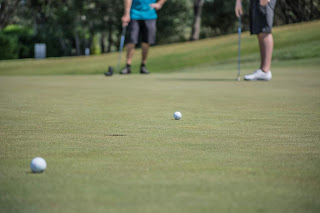 Brooks Koepka’s miraculous 2018 season was almost derailed before the calendar struck January 1st, 2018.
Brooks Koepka’s miraculous 2018 season was almost derailed before the calendar struck January 1st, 2018.A wrist injury in late December of 2017 was so severe that Koepka didn’t pick up a club for ninety-one days and forced the golfer to wear a soft cast for two months.
After sitting out the Masters, Koepka took the time to heal and focused his attention on defending his U.S. Open win in 2017. At Shinnecock, Koepka held off Tommy Fleetwood for a one-shot victory and won his second straight U.S. Open title.
Koepka added a victory to his major total later in 2018 at the PGA Championship.
So what made Koepka’s year so special? Here’s a deeper look at a few of the statistics that drove Koepka to be named the PGA Golfer of the Year in 2018.
Stat #1: 8th on the PGA Tour with Driving Distance of 313 yards
Due to the wrist injury in late 2017, Koepka wasn’t healthy enough to play in the 2018 Masters. So, despite missing almost the first third of the PGA Tour season, Koepka still finished the year with a Driving Distance average of 313 yards.Koepka’s ability to hit the ball over 320 yards came into play during the final round of the 2018 PGA Championship. When many of the golfers were dealing with tough decisions off the tee box at Bellerive, Koepka was putting the golf ball in places only one other golfer could touch as he averaged 324.2 yards of driving distance, good for second at the 2018 PGA Championship. Koepka’s long drives were the primary reason why he posted six birdies during Sunday’s final round score of 66, good for a two-shot win over Tiger Woods.
Stat #2: 3rd on the PGA Tour with a 2nd-round scoring average of 68.94 strokes
Brooks made the cut in 15 out of the 17 tournaments he played in 2018. The reason he advanced into the weekend at such a high rate was because of his exceptional play during his Friday rounds.Unlike his 2017 U.S. Open where he had two great rounds under his belt heading into the third round, Koepka struggled in round one of the 2018 U.S. Open. Brooks had two double bogeys and two bogeys over the opening 18 holes to finish with a 75 on Thursday. In danger of missing the cut, Koepka put together the most clutch second round of his career the following day. Six birdies against two bogeys in the second round put Koepka in a tie for third place and gave the Florida-native a renewed sense of confidence heading into the final two rounds.
At the 2018 PGA Championship, Koepka’s first round of 69 placed him five strokes behind the leader, but his record-tying 63 the next day vaulted him among the top players on the leaderboard and put him in a prime position to win his third career major.
Stat #3: 4th on the PGA Tour with a clubhead speed of 122.42 mph
When you look at the leaderboard of the hardest swingers on the PGA Tour, you’ll see several familiar names. Golfers with major victories such as Rory McIlroy, Dustin Johnson, and Bubba Watson are all over the top of the leaderboard for highest average clubhead speed in 2018. Amateurs are catching onto the secret that professional golfers have known for years, that higher swing speed off the tee box equals shorter second shots that lead to better birdie chances.Already known as one of the longest hitters on tour, Koepka’s raw swing speed statistics tell us why that is true. With an average clubhead speed of 122.42 mph, Brooks is one of the hardest swingers on tour, and his distance regularly puts him in a position to score low rounds. With a grip on the club of extreme quality, Koepka’s elite swing speed allows him to play the game with an aggressive and attacking style.
Stat #4: 1st on the PGA Tour with a Final-round scoring average of 68.27 strokes
One of Koepka’s most significant accomplishments in 2018 was his ability to close out tournaments when he had the lead. After playing an up-and-down first three rounds at the U.S. Open, Koepka needed a steady hand on the final Sunday to pick up his second straight U.S. Open title. With four golfers tied for the lead at the beginning of the fourth round, Koepka followed a shaky third round score of 72 with a title-clinching 68.Koepka also needed an exceptional final round on the last day of the PGA Championship even though he held a four-stroke lead over Tiger Woods as both golfers teed off that day. But it didn’t seem like he would need to dig much after a birdie on the first hole pushed Koepka’s lead to five strokes. But a combination of two birdies by Woods and two bogeys by Koepka over the next four holes erased Koepka’s lead and made the final 13 holes appointment viewing for golf lovers everywhere.
Koepka stayed steady by bombing long drives over 320 yards to create multiple birdie opportunities over the last 12 holes. His five birdies down the stretch held off the resurgent Woods for his second major title of 2018.
 Bio: Jordan Fuller is a golf enthusiast with over 25 years of experience on the green.
Bio: Jordan Fuller is a golf enthusiast with over 25 years of experience on the green.Over this lifetime, he’s fallen in love with the game and now teaches golf to amateur players in Omaha, Nebraska. He also loves to write and, every now and then, shares his learnings about the game in articles.
Nike Basketball [CC BY 3.0 (https://creativecommons.org/licenses/by/3.0)]










